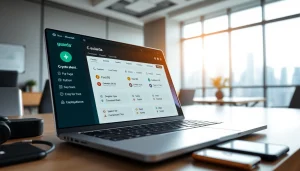Ultimate Guide to Exodus Wallet: Benefits and Features for 2025

Understanding the Exodus Wallet
What is the Exodus Wallet?
The exodus wallet is a cryptocurrency wallet that combines powerful features with a user-friendly interface. Designed for both novice and experienced users, Exodus is a hot wallet that supports a multitude of cryptocurrencies, allowing users to send, receive, and manage their digital assets seamlessly. Since its launch in 2016, it has grown significantly, now accommodating over 100 cryptocurrencies along with tools for swapping, tracking, and earning from these assets.
Unlike traditional exchange platforms that can be complicated and overwhelming, Exodus offers an intuitive design and a non-custodial model, meaning users have complete control over their private keys and funds. This gives Exodus wallet users peace of mind as they engage in cryptocurrency transactions.
Key Features of the Exodus Wallet
- User-Friendly Interface: Its intuitive design, accessible to users of all backgrounds, simplifies the process of managing cryptocurrencies.
- Multi-Currency Support: Users can manage a diverse portfolio with support for over 100 cryptocurrencies including Bitcoin (BTC), Ethereum (ETH), and many altcoins.
- Built-in Exchange: The wallet includes a built-in exchange feature which allows users to swap currencies without leaving the app, facilitating seamless transactions.
- Staking Features: Users can earn passive income by staking various coins directly within the wallet.
- 24/7 Support: The Exodus support team is always available to assist users with any inquiries or issues they may encounter.
How Exodus Wallet Works with Cryptocurrencies
Exodus operates on a simple yet robust architecture that allows users to interact with various cryptocurrencies effectively. Users can create a wallet for multiple currencies, store them securely, and easily convert assets through its integrated exchange.
When a user sends or receives funds, Exodus broadcasts those transactions to the corresponding blockchain. The wallet keeps track of all transactions and account balances, providing users with real-time updates. Notably, Exodus never holds users’ private keys, ensuring that assets are secure and accessible solely by the owners.
Setting Up Your Exodus Wallet
Step-by-Step Installation Process
To get started with Exodus, whether on a desktop or mobile device, follow these simple steps:
- Download: Visit the official Exodus website or app store and download the appropriate version for your device.
- Install: After downloading, install the wallet by following the prompts.
- Open the Wallet: Launch the application once it’s installed, where you’ll be greeted by a user-friendly onboarding process.
- Wallet Creation: Follow the prompts to create a new wallet. You’ll be provided with a unique recovery phrase—store it securely, as this is your key to restoring access.
Creating and Securing Your Wallet
Once you have your new wallet set up, security should be your top priority. Though Exodus is designed with various security features, users must take additional steps to protect their assets:
- Secure Recovery Phrase: Store your recovery phrase in a physical and secure location, never online or in unsecured digital formats.
- Password Protection: Set up a strong password to access your wallet, enhancing your defense against unauthorized access.
- Two-Factor Authentication: While Exodus doesn’t support 2FA directly in the app, consider using strong device security measures such as biometric access and encryption for your devices.
Linking Your Exodus Wallet to Exchanges
Although Exodus is a wallet-first platform, users may want to link their wallet to various cryptocurrency exchanges to enable buying and selling cryptocurrencies. The process is generally straightforward:
- Choose an Exchange: Select an exchange that supports integration with wallets like Exodus.
- Generate an Address: Within your Exodus wallet, generate a receiving address for the cryptocurrency you wish to trade.
- Transfer Funds: Using the exchange, send funds to your Exodus wallet address, ensuring you double-check the address before executing transactions.
Using the Exodus Wallet for Transactions
How to Buy Cryptocurrencies through Exodus
Exodus has simplified the process of buying cryptocurrencies directly within its interface. Users can purchase crypto using debit or credit cards through integrated services like Sardine:
- Select Currency: Choose the cryptocurrency you wish to purchase from the available options.
- Input Payment Details: Enter your payment method and the amount you want to buy.
- Confirm Transaction: After reviewing the details, confirm the purchase. Your crypto will be instantly reflected in your wallet.
Swapping Assets with Exodus Wallet
One of the standout features of the Exodus wallet is its built-in exchange function, allowing users to swap cryptocurrencies without leaving the wallet:
- Select Assets: Choose the cryptocurrencies you want to swap.
- Enter Amount: Input the amount you wish to exchange.
- Review Rate: Check the exchange rate and any associated fees before finalizing the transaction.
- Confirm Swap: Once satisfied, confirm the swap. The assets will be exchanged in your wallet promptly.
Fees Associated with Transactions
While using the Exodus wallet is free of registration fees, users should be aware of transaction costs associated with trading:
- Network Fees: Each transaction incurs network fees that are dependent on the cryptocurrency being transacted; these fees go to miners who process the transactions on respective blockchains.
- Pricing Spread: Exodus charges a spread on trades, which can vary widely based on market conditions. This spread can make the wallet slightly more expensive for frequent traders compared to dedicated exchanges.
Security Features of the Exodus Wallet
Understanding Wallet Security Options
Exodus incorporates a range of security features designed to shield users from potential threats:
- Private Keys: Exodus stores private keys locally on users’ devices. This means only the user has access to their funds.
- Data Encryption: All data within the wallet is encrypted, providing a robust layer of protection against data breaches.
- Transaction Alerts: Users receive notifications of transactions, helping them quickly identify unauthorized actions.
Cold Storage vs. Hot Wallets
Exodus is primarily a hot wallet, meaning it is connected to the internet and relatively easy to use. However, it’s crucial to understand the distinction between hot wallets like Exodus and cold storage solutions:
- Hot Wallets: These wallets are convenient for frequent transactions but are considered more vulnerable to hacks and phishing attacks due to their online nature.
- Cold Storage: This method involves keeping assets offline on hardware or paper wallets, significantly increasing security but reducing accessibility for frequent transactions.
Common Security Practices for Exodus Wallet Users
To maximize the security of their funds, Exodus wallet users should adopt best practices, such as:
- Regular Software Updates: Always keep the Exodus wallet app updated to benefit from the latest security features and bug fixes.
- Beware of Phishing: Approach unsolicited messages claiming to be from Exodus with caution. Always verify the source before clicking links or providing sensitive information.
- Backup Wallet: Regularly back up wallet information and recovery phrases in secure offline locations.
Advanced Tips and Best Practices for Exodus Wallet
Maximizing Your Crypto Portfolio with Exodus
Effective portfolio management is crucial for long-term success in the cryptocurrency space. Exodus offers several features to optimize your crypto investments:
- Diversification: Spread investments across various cryptocurrencies to mitigate risks associated with market volatility.
- Using Wallet Analytics: Exodus provides tools to track portfolio performance. Analyzing these metrics can help users make informed decisions regarding buying or selling assets.
- Regular Re-evaluation: Periodically reassess your investment strategy based on market trends and personal financial goals.
Integrating Exodus Wallet with Other Tools
Exodus offers integrations with various tools and platforms to enhance user experience and expand functionalities:
- Exchange Integrations: Connect Exodus with decentralized exchanges (DEXs) for greater trading options directly through your wallet.
- Price Tracking Apps: Utilize accompanying apps to keep track of price movements and market trends, optimizing your trading strategies.
- DeFi Platforms: Explore Decentralized Finance (DeFi) opportunities by linking the wallet with DeFi protocols for yield farming or liquidity provision.
Future Updates and Features to Watch For
The cryptocurrency landscape is ever-evolving, and Exodus is committed to integrating new features that meet user demands:
- Enhanced Security Protocols: Regular enhancements are made to security measures as threats evolve in the digital space.
- Additional Currency Support: As the cryptocurrency market grows, so does the interest in altcoins. Future updates are likely to include even more coins and tokens.
- Improved User Interface: User feedback drives continuous enhancement of usability and accessibility, ensuring the best experience for all users.







